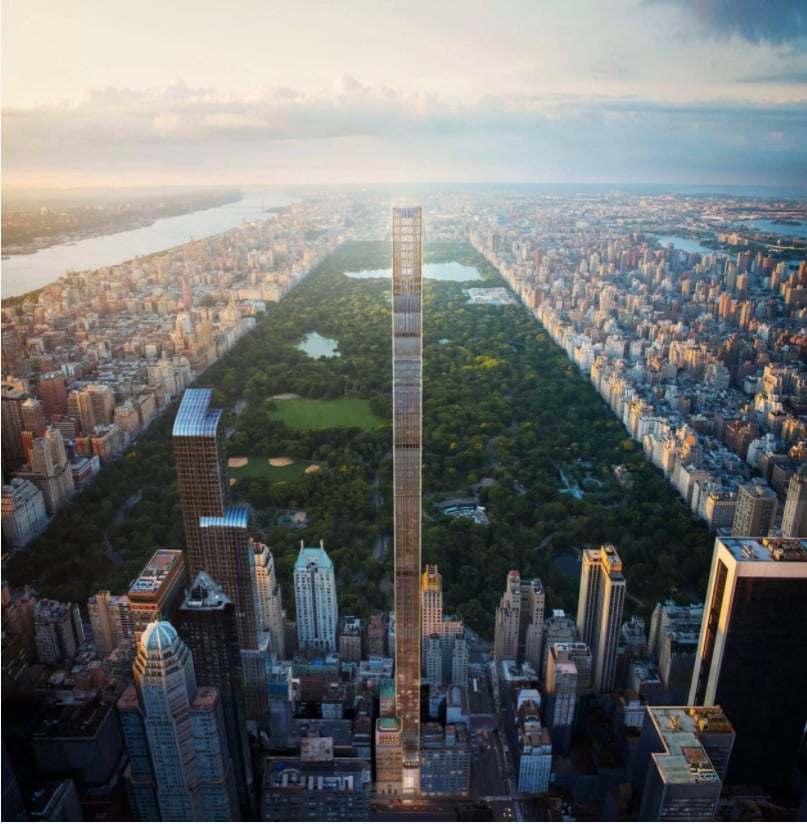
It is, by several different measures, landmark news.
Interviewed by Bloomberg Markets: The Close on May 24, Guggenheim Partners co-founder Todd Morley announced plans to create the world’s biggest museum dedicated to NFTs, the digital art ownership tokens that have exploded into the news in recent months. The new attraction is set to be located within a 1,428-foot-tall skyscraper located at 111 West 57th Street, just four blocks from the Museum of Modern Art.
The 84-floor building, also hyped as the world’s “skinniest tower,” has been in development for years by JDS Development Group, though its completion was pushed back due to the pandemic. Designed by SHoP Architects, it is set to be clad in Art Deco-inspired terra cotta, glass, and bronze ornament.
On Bloomberg Markets, Morley revealed to the world that the new luxury perch would have some amenities not currently listed on the building’s official site. For one, he says that it will also serve as an antennae for his company, Overline, which is pushing a protocol that allows communication between different blockchain networks.
“It’s the perfect place, sort of a symbol of technology, to announce new technology,” Morley said. “This one building will be able to connect—sort of like a ham radio operator—connect everybody in New York City to wireless trading, wireless crypto trading, wireless communication.”
The sun rises on 111 West 57th Street also known as it is under construction on November 2, 2019, in New York City. (Photo by Gary Hershorn/Getty Images)
Morley also promised a related NFT museum—though his explanation for what it might offer was difficult to parse. “Part of the building at 111 is to create world’s largest NFT museum,” he explained. “So that’s kind of the utility function inside the building rather than just owning the bricks and mortar, so to speak. So we think that Overline will be the progenitor of many projects that people can own.”
Bloomberg Markets host Caroline Hyde pressed Morley on the obvious question: Why do you even need a physical museum for digital art?
In response, the investment kingpin seemed to suggest—albeit via more garbled business-speak—that the proposed NFT museum was explicitly intended as an advertisement, for both the real-estate development at 111 West 57th itself and for his own company’s operations:
Depends on what you mean by museum, right? The Guggenheim Museum has had phenomenal success at becoming a real estate development tool using culture to develop assets and convene people. So we think there’s that. But we are also very interested in global infrastructure—technology-driven infrastructure. So it gives us the ability to not only allow investment into those areas but to sort of capture the culture of those areas. So it becomes a global ambassador, a digital ambassador, if you will—so why not centrally located in the tallest building in New York?
(Guggenheim Partners, the investment group Morley co-founded, and the Guggenheim Museum are related to the same family fortune, but not directly connected.)
The news comes after a large-scale price plunge in cryptocurrency, triggered after billionaire svengali Elon Musk expressed concern over its ecological impact (mining of Bitcoin and Ethereum, the two largest cryptocurrencies, currently pumps as much carbon into the atmosphere as a mid-sized European nation). Some have credited the general-public interest stimulated by NFTs with drawing greater scrutiny to the devastating and unsustainable environmental toll of the technology.
In the Bloomberg interview, Morley repeatedly refers to 111 West 57th as the tallest building in New York. It will be the third tallest building in New York, after One World Trade and the nearby Central Park Tower.